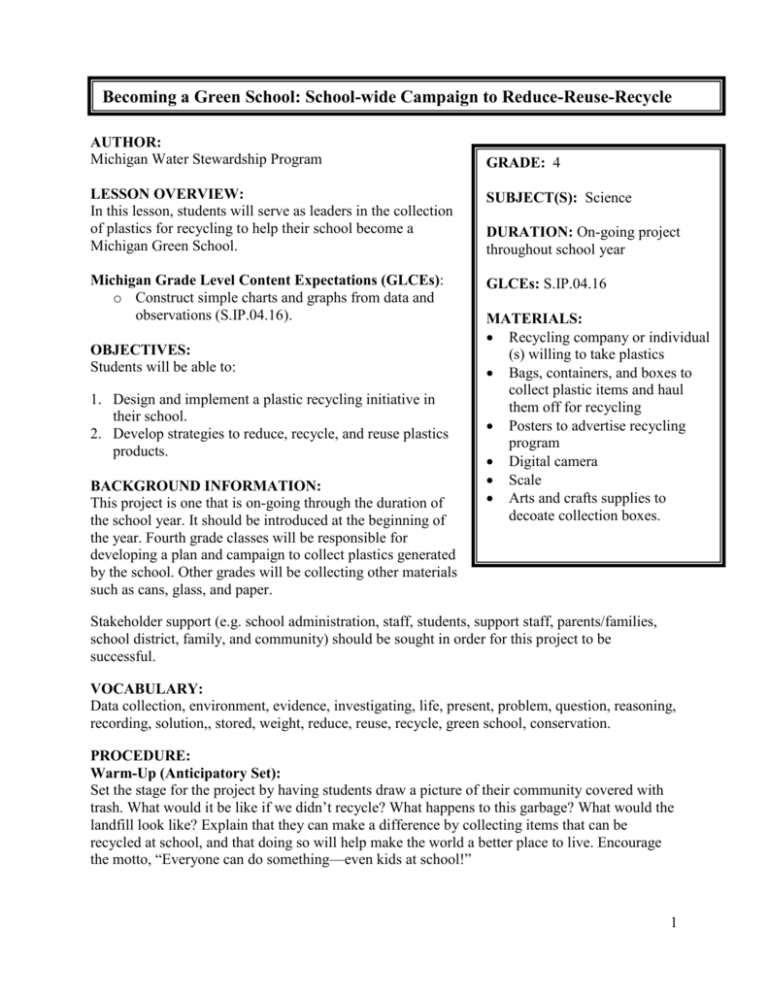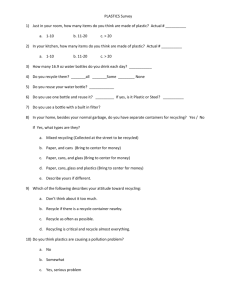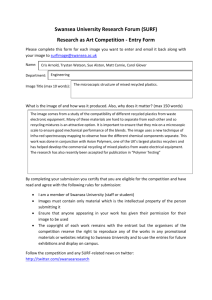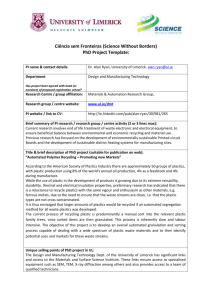Green Schools Recycling Campaign
advertisement

Becoming a Green School: School-wide Campaign to Reduce-Reuse-Recycle Plastics AUTHOR: Michigan Water Stewardship Program GRADE: 4 LESSON OVERVIEW: In this lesson, students will serve as leaders in the collection of plastics for recycling to help their school become a Michigan Green School. SUBJECT(S): Science Michigan Grade Level Content Expectations (GLCEs): o Construct simple charts and graphs from data and observations (S.IP.04.16). GLCEs: S.IP.04.16 OBJECTIVES: Students will be able to: 1. Design and implement a plastic recycling initiative in their school. 2. Develop strategies to reduce, recycle, and reuse plastics products. BACKGROUND INFORMATION: This project is one that is on-going through the duration of the school year. It should be introduced at the beginning of the year. Fourth grade classes will be responsible for developing a plan and campaign to collect plastics generated by the school. Other grades will be collecting other materials such as cans, glass, and paper. DURATION: On-going project throughout school year MATERIALS: Recycling company or individual (s) willing to take plastics Bags, containers, and boxes to collect plastic items and haul them off for recycling Posters to advertise recycling program Digital camera Scale Arts and crafts supplies to decoate collection boxes. Stakeholder support (e.g. school administration, staff, students, support staff, parents/families, school district, family, and community) should be sought in order for this project to be successful. VOCABULARY: Data collection, environment, evidence, investigating, life, present, problem, question, reasoning, recording, solution,, stored, weight, reduce, reuse, recycle, green school, conservation. PROCEDURE: Warm-Up (Anticipatory Set): Set the stage for the project by having students draw a picture of their community covered with trash. What would it be like if we didn’t recycle? What happens to this garbage? What would the landfill look like? Explain that they can make a difference by collecting items that can be recycled at school, and that doing so will help make the world a better place to live. Encourage the motto, “Everyone can do something—even kids at school!” 1 Activity: Before beginning this project, have students observe what kinds of plastics are generated in the school. What are the different types of plastics? The types are summarized in this table: Type of Recyclable Plastics: Number Type of Plastic 1 (Most commonly recyclable) PETE 2 (Most commonly recycled) HDPE 3 PVC 4 LDPE 5 PP 6 PS 7 OTHER Which are recyclable and which are not? For those that are not, can these items be reused? Can you eliminate the use of the items so that they don’t have to be thrown away? After researching the types of plastics that you will be collecting for recycling, develop a plan to have a local recycler pick up these items. Be sure to find out if they will collect bagged items or if they must be in a special collection container. If your area does pick-up, determine whether families would be willing to pick up and recycle the collected items. Gather samples of each type of plastic (a few for each number if you can find them) and demonstrate which plastics will be collected for recycling or reuse. Share with students the importance of recycling and its purpose. This will help engage the students and they will become excited about the project. Create posters to advertise the project that can be placed around the school and out in the community. Kitchen staff will also need to be included in the set-up process. This will take a little more work on their part to wash and set aside plastics. Create and design collection boxes. Place them in designate collection points. Collection boxes will need to be checked periodically. Also share information with the community as they can share some great tips to aid in the campaign. Continue to collect plastics and weigh them during each collection time. In their science journals, have students keep track of his data, specifically how much is collected and where it is from. Take pictures with a digital camera to record various activities of the project. 2 Periodically question the students about the amounts being collected and question them about the project. They must use reasoning and have a solution to these problems. Write articles for local newspapers in your community. Include photos of students collecting plastics for recycling. Wrap-Up (Closure): At the end of the year or designated project period, total the weight of all items collected. Graph your data. Create a report to share with those in your school and community. In this report, include data on the amount of plastics recycled, comments from students and teachers, and other thoughts on the project.ideas ASSESSMENT OPTION: We use a lot of plastic products in our daily lives. Not all of it can be recycled. What can we do to avoid using these non-recycled plastics? If it’s not possible to stop using these plastic items, how can these items be reused? EXTENSIONS: Students may question you about what they can be done with the different types of recycled plastic. This is a great opportunity to have students conduct research on using recycled plastics to make new items. RESOURCES: Michigan Green School Web Site: http://www.michigangreenschools.org/home.html Green Schools Initiative: http://www.greenschools.net/ 3






